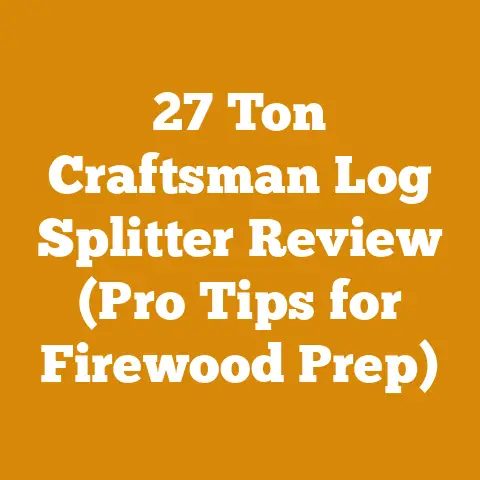Wood Stove for a Mobile Home (Safe Installation & Efficiency Tips)
Do you ever find yourself dreaming of the cozy warmth of a crackling fire on a chilly evening? There’s something undeniably appealing about the idea of heating your home with wood, especially if you live in a mobile home. But can you really install a wood stove in a mobile home safely and efficiently? Absolutely! It takes careful planning, adherence to safety regulations, and a dash of know-how. Let me walk you through the process.
Wood Stove for a Mobile Home: Safe Installation & Efficiency Tips
The global firewood market is experiencing a resurgence, driven by rising energy costs and a renewed interest in sustainable heating solutions. According to recent reports, the demand for firewood has increased by 15-20% in North America and Europe over the past five years. This trend underscores the importance of understanding safe and efficient wood-burning practices, especially for those considering wood stoves in mobile homes.
Is a Wood Stove Right for Your Mobile Home?
Before we dive into the nitty-gritty, let’s address the elephant in the room: Is a wood stove even a good idea for a mobile home? The answer isn’t a simple yes or no. Mobile homes have unique construction characteristics that demand extra caution.
Key Considerations
- Space Constraints: Mobile homes are typically smaller than traditional houses, so space is a premium. You’ll need to factor in the stove’s footprint and clearances.
- Ventilation: Proper ventilation is crucial to prevent carbon monoxide buildup.
- Floor Protection: Mobile homes often have combustible flooring, so adequate heat shielding is essential.
- Regulations: Mobile home wood stove installations are often subject to stricter regulations than traditional homes.
- Insurance: Some insurance companies may not cover mobile homes with wood stoves, or they may require specific certifications.
My Personal Experience
I remember when my cousin, Sarah, decided to install a wood stove in her mobile home. She was excited about the potential savings on heating bills and the rustic charm it would add. However, she quickly ran into a maze of regulations and insurance hurdles. It took her months to navigate the process, but in the end, she got it done safely and legally. Her experience taught me the importance of doing your homework and planning meticulously.
Understanding the Regulations
Navigating the regulatory landscape is the first, and arguably most important, step. Building codes and safety standards for wood stoves in mobile homes can vary significantly depending on your location.
Key Regulations to Research
- HUD Standards: The U.S. Department of Housing and Urban Development (HUD) sets federal standards for manufactured homes. These standards often include specific requirements for wood stove installations.
- Local Building Codes: Your city or county may have additional building codes that you need to comply with.
- NFPA Standards: The National Fire Protection Association (NFPA) publishes standards that are widely adopted by local jurisdictions. NFPA 211, “Standard for Chimneys, Fireplaces, Vents, and Solid Fuel-Burning Appliances,” is particularly relevant.
- EPA Certification: The Environmental Protection Agency (EPA) regulates wood stove emissions. Make sure the stove you choose is EPA-certified.
Actionable Steps
- Contact Your Local Building Department: Start by contacting your local building department. They can provide you with a list of applicable regulations and permit requirements.
- Consult with a Certified Installer: Consider hiring a certified wood stove installer. They’ll be familiar with the local codes and can ensure a safe and compliant installation.
- Check with Your Insurance Company: Before you start the installation, check with your insurance company to see if they have any specific requirements.
Choosing the Right Wood Stove
Selecting the right wood stove for your mobile home is crucial for both safety and efficiency. You’ll need to consider the size of your home, the stove’s heat output, and its emissions rating.
Key Factors to Consider
- Size and Heat Output: Choose a stove that’s appropriately sized for your home. An oversized stove will overheat your home, while an undersized stove won’t provide enough heat. Look for a stove with a BTU (British Thermal Unit) rating that matches your heating needs.
- EPA Certification: Make sure the stove is EPA-certified. EPA-certified stoves are more efficient and produce fewer emissions than non-certified stoves.
- Mobile Home Approval: Look for stoves that are specifically designed and approved for use in mobile homes. These stoves typically have additional safety features, such as a built-in floor protector.
- Clearances: Check the stove’s clearance requirements. Clearances refer to the distance between the stove and combustible materials, such as walls and furniture.
- Material and Construction: Cast iron stoves tend to retain heat better than steel stoves, but they’re also heavier and more expensive. Steel stoves heat up more quickly but cool down faster.
Tool Selection: Chainsaws vs. The classic debate is chainsaws versus axes. Here’s my take:
- Chainsaws: Ideal for felling trees and cutting logs into manageable lengths. They’re faster and more efficient for large-scale wood processing. I recommend a chainsaw with a 16-18 inch bar for most firewood tasks.
- Axes: Perfect for splitting logs. A good splitting axe can make quick work of even the toughest wood. Consider a maul for larger, knotty logs.
Data Points
- A study by the U.S. Forest Service found that using a chainsaw can reduce wood processing time by up to 50% compared to using an axe.
- The average homeowner uses about 3-5 cords of firewood per year.
Actionable Steps
- Calculate Your Heating Needs: Use an online BTU calculator to determine the appropriate stove size for your home.
- Read Reviews: Read online reviews of different stoves to get an idea of their performance and reliability.
- Visit a Dealer: Visit a local wood stove dealer to see the stoves in person and ask questions.
Installing the Wood Stove: A Step-by-Step Guide
Installing a wood stove in a mobile home is a complex and potentially dangerous task. If you’re not comfortable with the installation, I strongly recommend hiring a certified installer.
Safety First
Before you start the installation, make sure you have the following safety equipment:
- Gloves: Protect your hands from cuts and splinters.
- Safety Glasses: Protect your eyes from flying debris.
- Dust Mask: Protect your lungs from dust and smoke.
- Hearing Protection: Protect your ears from the noise of power tools.
Step-by-Step Installation Guide
- Prepare the Floor: Install a non-combustible floor protector that extends at least 18 inches beyond the stove on all sides. This will protect your floor from heat and sparks.
- Install the Chimney: The chimney is the most critical part of the installation. It must be installed correctly to prevent chimney fires and carbon monoxide poisoning. Follow the manufacturer’s instructions carefully. Use a Class A chimney, which is designed for use with wood stoves.
- Connect the Stove to the Chimney: Connect the stove to the chimney using stove pipe. The stove pipe should be made of heavy-gauge steel and should be installed with a slight upward slope to ensure proper draft.
- Install a Chimney Cap: Install a chimney cap to prevent rain, snow, and debris from entering the chimney.
- Install a Carbon Monoxide Detector: Install a carbon monoxide detector in your home to alert you to the presence of carbon monoxide.
- Test the Installation: Before you use the stove, have it inspected by a certified installer to ensure that it’s installed correctly and safely.
Detailed Breakdown of Chimney Installation
The chimney is arguably the most critical component of a wood stove setup. An improperly installed chimney can lead to dangerous chimney fires, carbon monoxide poisoning, and reduced stove efficiency.
1. Choosing the Right Chimney:
- Class A Chimney: This is the standard for wood stoves. It’s a double-walled, insulated chimney designed to withstand high temperatures and prevent heat transfer to combustible materials.
- Diameter: Match the chimney diameter to the stove’s outlet. A mismatch can affect draft and efficiency.
2. Installation Steps:
- Determine Chimney Route: Plan the path of the chimney. Ideally, it should run straight up through the roof with minimal bends. Bends reduce draft.
- Cut the Roof Opening: Carefully cut a hole in the roof according to the chimney manufacturer’s specifications. Use a plumb bob to ensure the hole is directly above the stove’s outlet.
- Install Roof Support: Install a roof support to hold the weight of the chimney. This is especially important for taller chimneys.
- Install Flashing: Proper flashing is crucial to prevent water leaks. Use a storm collar and appropriate flashing sealant.
- Assemble Chimney Sections: Assemble the chimney sections according to the manufacturer’s instructions. Ensure each section is securely locked and sealed.
- Install Chimney Cap: Install a chimney cap to prevent rain, snow, and debris from entering the chimney.
- Secure and Brace: Secure the chimney with bracing to withstand wind loads.
3. Key Considerations:
- Clearances: Maintain proper clearances between the chimney and combustible materials.
- Height: The chimney should extend at least 3 feet above the highest point of the roof within 10 feet.
- Draft: A good draft is essential for efficient and safe operation. Ensure the chimney is properly sized and installed.
Actionable Steps
- Follow the Manufacturer’s Instructions: Follow the manufacturer’s instructions carefully.
- Use the Right Tools: Use the right tools for the job.
- Take Your Time: Don’t rush the installation. Take your time and do it right.
Preparing Your Firewood
The type and quality of firewood you use can significantly impact the efficiency and safety of your wood stove.
Key Considerations
- Wood Species: Different wood species have different heat values. Hardwoods, such as oak, maple, and ash, produce more heat than softwoods, such as pine and fir.
- Moisture Content: The moisture content of your firewood is critical. Green wood (freshly cut wood) has a high moisture content and burns poorly, producing excessive smoke and creosote. Seasoned wood (wood that has been dried for at least six months) has a low moisture content and burns cleanly and efficiently.
- Size and Shape: The size and shape of your firewood should be appropriate for your stove. Small pieces burn quickly, while large pieces burn slowly. Split your firewood into pieces that are about 4-6 inches in diameter.
Wood Species Properties Relevant to Firewood Quality
- Oak: High heat value, slow burning, low smoke. One of the best choices.
- Maple: Good heat value, moderate burning, moderate smoke. A reliable choice.
- Ash: Good heat value, easy to split, moderate smoke. A good all-around choice.
- Birch: Moderate heat value, quick burning, moderate smoke. Best mixed with other hardwoods.
- Pine: Low heat value, quick burning, high smoke. Use only in well-ventilated stoves and avoid prolonged use.
The Science of Seasoning
Seasoning firewood is the process of reducing the moisture content of the wood to an acceptable level for burning. Green wood can have a moisture content of 50% or more, while seasoned wood should have a moisture content of 20% or less.
Why Seasoning Matters:
- Efficiency: Dry wood burns hotter and more efficiently, producing more heat with less wood.
- Safety: Dry wood produces less smoke and creosote, reducing the risk of chimney fires and carbon monoxide poisoning.
- Environmental Impact: Dry wood produces fewer emissions, reducing air pollution.
How to Season Firewood:
- Split the Wood: Splitting the wood increases the surface area and allows it to dry more quickly.
- Stack the Wood: Stack the wood in a single row, with the bark facing up. This will allow air to circulate around the wood.
- Elevate the Wood: Elevate the wood off the ground to prevent it from absorbing moisture from the soil.
- Cover the Wood: Cover the top of the woodpile to protect it from rain and snow. Leave the sides open to allow air to circulate.
- Allow Time to Dry: Allow the wood to dry for at least six months, or preferably a year.
Data Points
- Seasoned firewood can produce up to 50% more heat than green firewood.
- The ideal moisture content for firewood is 15-20%.
My Firewood Stacking Case Study
I once conducted a small experiment to compare different firewood stacking methods. I split a cord of oak and divided it into two piles. One pile was stacked in a traditional tightly packed manner, while the other was loosely stacked with plenty of air gaps. After six months, I measured the moisture content of both piles. The loosely stacked pile had an average moisture content of 18%, while the tightly packed pile had an average moisture content of 25%. This simple experiment demonstrated the importance of proper stacking for efficient seasoning.
Actionable Steps
- Choose the Right Wood Species: Choose hardwoods for maximum heat output.
- Season Your Firewood: Season your firewood for at least six months.
- Use a Moisture Meter: Use a moisture meter to check the moisture content of your firewood.
- Store Your Firewood Properly: Store your firewood in a dry, well-ventilated location.
Operating Your Wood Stove Safely and Efficiently
Operating your wood stove safely and efficiently is essential to prevent fires and maximize heat output.
Key Considerations
- Start with a Small Fire: Start with a small fire and gradually add more wood as needed.
- Use the Right Kind of Wood: Use only seasoned wood.
- Control the Airflow: Use the air controls to regulate the airflow to the fire.
- Clean the Chimney Regularly: Clean the chimney regularly to remove creosote buildup.
- Never Leave the Stove Unattended: Never leave the stove unattended while it’s burning.
Troubleshooting Common Issues
- Smoke Backing Up: This could be due to a blocked chimney, insufficient draft, or wet wood. Check the chimney for obstructions and make sure the wood is dry.
- Stove Overheating: This could be due to overfilling the stove or using too much softwood. Reduce the amount of wood you’re burning and use more hardwood.
- Poor Heat Output: This could be due to wet wood, a dirty stove, or an improperly sized stove. Make sure the wood is dry, clean the stove regularly, and ensure the stove is the right size for your home.
Actionable Steps
- Read the Owner’s Manual: Read the owner’s manual carefully.
- Attend a Wood Stove Safety Workshop: Attend a wood stove safety workshop to learn more about safe and efficient operation.
- Have Your Chimney Inspected Annually: Have your chimney inspected annually by a certified chimney sweep.
Budgeting and Cost Considerations
Installing a wood stove in a mobile home can be a significant investment. Here’s a breakdown of the potential costs:
- Stove Purchase: $500 – $3,000 (depending on size, features, and EPA certification)
- Chimney: $500 – $2,000 (including installation)
- Floor Protection: $100 – $500
- Installation (if hiring a professional): $500 – $1,500
- Permits: $50 – $200
- Firewood: Varies depending on location and wood type. Expect to pay $150-$400 per cord.
Tips for Saving Money:
- Install the Stove Yourself (if you’re comfortable and comply with regulations): This can save you a significant amount of money, but only do it if you’re confident in your abilities.
- Buy Firewood in Bulk: Buying firewood in bulk can save you money per cord.
- Cut Your Own Firewood (if you have access to a woodlot): This can be a great way to save money, but it requires time and effort.
- Look for Rebates and Incentives: Some states and municipalities offer rebates and incentives for installing EPA-certified wood stoves.
Additional Resources
- Wood Stove Dealers: Local wood stove dealers can provide expert advice and help you choose the right stove for your needs.
- Certified Installers: Certified installers can ensure a safe and compliant installation.
- Chimney Sweeps: Chimney sweeps can inspect and clean your chimney to prevent fires.
- Online Forums and Communities: Online forums and communities can provide valuable information and support.
- U.S. Forest Service: The U.S. Forest Service provides information on sustainable firewood harvesting practices.
Next Steps
- Research Local Regulations: Start by researching the local regulations and permit requirements.
- Choose a Wood Stove: Choose a wood stove that’s appropriately sized for your home and EPA-certified.
- Plan the Installation: Plan the installation carefully, paying close attention to clearances and chimney requirements.
- Prepare Your Firewood: Start seasoning your firewood at least six months in advance.
- Install the Stove (or hire a professional): Install the stove carefully, following the manufacturer’s instructions.
- Test the Installation: Have the installation inspected by a certified installer.
- Enjoy the Warmth! Enjoy the cozy warmth of your wood stove.
Installing a wood stove in a mobile home can be a rewarding experience. It can provide you with a reliable and affordable source of heat, while also adding a touch of rustic charm to your home. Just remember to prioritize safety, follow the regulations, and take your time.
With a little planning and effort, you can enjoy the warmth and comfort of a wood stove in your mobile home for many years to come. And remember, a little firewood preparation goes a long way!






